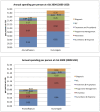Malaria control and elimination in Sri Lanka: documenting progress and success factors in a conflict setting
- PMID: 22952642
- PMCID: PMC3430652
- DOI: 10.1371/journal.pone.0043162
Malaria control and elimination in Sri Lanka: documenting progress and success factors in a conflict setting
Abstract
Background: Sri Lanka has a long history of malaria control, and over the past decade has had dramatic declines in cases amid a national conflict. A case study of Sri Lanka's malaria programme was conducted to characterize the programme and explain recent progress.
Methods: The case study employed qualitative and quantitative methods. Data were collected from published and grey literature, district-level and national records, and thirty-three key informant interviews. Expenditures in two districts for two years--2004 and 2009--were compiled.
Findings: Malaria incidence in Sri Lanka has declined by 99.9% since 1999. During this time, there were increases in the proportion of malaria infections due to Plasmodium vivax, and the proportion of infections occurring in adult males. Indoor residual spraying and distribution of long-lasting insecticide-treated nets have likely contributed to the low transmission. Entomological surveillance was maintained. A strong passive case detection system captures infections and active case detection was introduced. When comparing conflict and non-conflict districts, vector control and surveillance measures were maintained in conflict areas, often with higher coverage reported in conflict districts. One of two districts in the study reported a 48% decline in malaria programme expenditure per person at risk from 2004 to 2009. The other district had stable malaria spending.
Conclusions/significance: Malaria is now at low levels in Sri Lanka--124 indigenous cases were found in 2011. The majority of infections occur in adult males and are due to P. vivax. Evidence-driven policy and an ability to adapt to new circumstances contributed to this decline. Malaria interventions were maintained in the conflict districts despite an ongoing war. Sri Lanka has set a goal of eliminating malaria by the end of 2014. Early identification and treatment of infections, especially imported ones, together with effective surveillance and response, will be critical to achieving this goal.
Conflict of interest statement
Figures






References
-
- Karunaratne WA (1959) The Influence of Malaria Control on Vital Statistics in Ceylon. The Journal of Tropical Medicine and Hygiene 62: 79–85. - PubMed
-
- Rajendram S, Jayewickreme SH (1951) Malaria in Ceylon. Part I. The control and prevention of epidemic malaria by the residual spraying of houses with D.D.T. Indian Journal of Malariology 5: 1–73. - PubMed
-
- The World Health Organization DoME (1961) Review of Quarterly Reports in Surveillance Operations in 1960. Geneva: World Health Organization WHO/Mal/289.
-
- Pinikahana J, Dixon RA (1993) Trends in Malaria Morbidity and Mortality in Sri Lanka. Indian Journal of Malariology 30: 51–55. - PubMed
Publication types
MeSH terms
Substances
LinkOut - more resources
Full Text Sources
Medical
Miscellaneous

